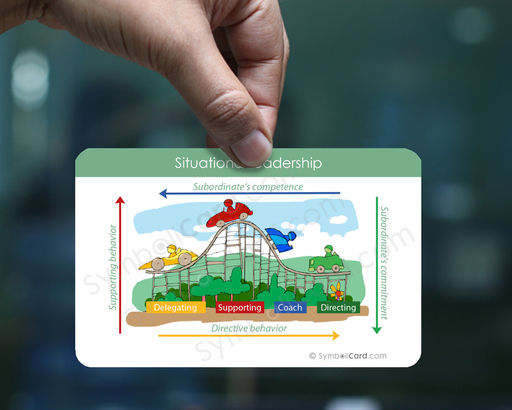Situational leadership
The use of the card during the development process:
To be a good leader you need to take into consideration your subordinates' competence. According to Blanchard there are 4 phases of the subordinates' competence, meanwhile the leadership still also consists of 4 phases.
The four fundamental leadership styles:
1. Directing - This leadership approach is most appropriate when the followers have low willingness and low ability for the task at hand. When the followers cannot do the job and are unwilling or afraid to try, then the leader must take a highly directive role. Directing requires those in charge to define the roles and tasks of the followers, and supervise them closely.
2. Coaching - This leadership approach is most appropriate when the followers have high willingness but low ability for the task at hand. Like Directing, Coaching still requires leaders to define roles and tasks clearly, but the leader seeks ideas and suggestions from the follower. Decisions remain the leader's prerogative, but communication is much more two-way.
3. Supporting - This leadership approach is most appropriate when the followers have low willingness but high ability for the task at hand. Supportive leadership works when the follower can do the job, but is refusing to do it or showing a lack of commitment. The leader should be concerned with finding out why the followers are refusing and work to persuade them to cooperate.
4. Delegating - This leadership approach is most appropriate when the followers have high willingness and high ability. Leaders should rely on delegating when the follower can do the job and is motivated to do it. There is a high amount of trust that the follower will do well, and the follower requires little supervision or support.Delegating still keeps the leader involved in the decisions and problem-solving, but execution is mostly in the hands of the followers.
Before one selects a leadership style to use, they must first understand the situation and the importance of the possible outcomes. Then the leader may choose one of the four leadership styles and act accordingly.
There are two fundamental leadership behavior used to influence others:
Ø The directive behavior can be described by 3 key words: giving direction, controlling and supervision.
Ø The supportive behavior stands for praising, listening, backing up.
From the point of view of the subordinates' competence 2 dimensions are described the best by expertise and committment.
Leaders need to learn to apply the leadership styles flexibly, recognize the individual needs and last but not least leaders shall make an agreement with the subordinates, based on that choose the style aligned with their expectations. Three key words are: flexibility, reality assessment and style allignment.
Page URL
The current page primary URL: https://symbolicard.com/symbolic-coach-card-situational-leadership-133/
The current page additional URL: https://symbolicard.com/doc133/







